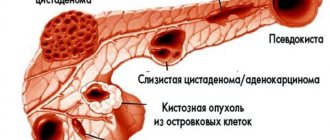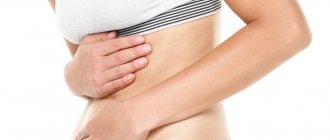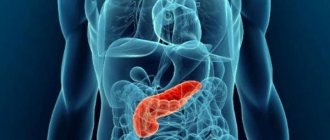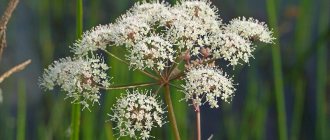Pancreatic diseases
The digestion process is impossible without pancreatic juice, which is produced in the pancreas. It has 3 sections - head, body, tail. This gland has a complex structure, and the functions of the organ are very important. Its secretion is involved in the breakdown of proteins, fats, carbohydrates, and it produces the hormones glucagon and insulin.
When the functions of the gland are impaired, serious diseases develop, the most common of which are:
- pancreatitis (acute and chronic);
- autoimmune pancreatitis;
- pancreatic necrosis;
- cyst;
- stones;
- cancer.
The functioning of the organ affects energy metabolism; these diseases can lead to diabetes.
Who to contact?
Depending on the severity of symptoms, you can contact:
- therapist;
- gastroenterologist;
- endocrinologist;
- surgeon;
- oncologist.
If the patient cannot independently choose the right doctor, then he should make an appointment with a therapist, who, if necessary, will refer him to a specialist.
Therapist
The therapist treats chronic pancreatitis without exacerbations and other diseases of the pancreas on an outpatient basis. He prescribes medication: selects analgesics and drugs that help digest food. If the therapist fails to cope with the disease, he refers the patient to a gastroenterologist.
Gastroenterologist
In case of acute pancreatitis, the patient is hospitalized and treated by a gastroenterologist. First of all, the specialist will select a strict diet. In the first few days, the patient drinks only alkaline water to restore the functioning of the organ. Then you can gradually eat light food.
The doctor will also prescribe special enzymes that will facilitate the work of the pancreas and help return it to normal, probiotics, vitamin complexes, and immunomodulators.
Endocrinologist
You will have to contact this specialist if blood tests show an increased glucose concentration, which may be a consequence of diabetes mellitus. Once the diagnosis is confirmed, the endocrinologist will prescribe a diet and insulin administration, and select the required dosage of the hormone.
Surgeon
During an attack of acute pancreatitis or exacerbation of chronic pancreatitis, the patient is admitted to the surgical department. First, the surgeon applies conservative treatment: puts in IVs, prescribes painkillers and drugs that regulate the secretion of digestive enzymes. But if complications arise, he resorts to surgery. After the elimination of acute symptoms, further therapy is carried out by a gastroenterologist.
In case of extensive necrosis, the patient is taken to the intensive care unit or intensive care unit, where a resuscitator, together with a surgeon, treats him.
Oncologist
If malignant tumors are discovered during the examination, the patient is referred to an oncologist. He will prescribe a course of chemotherapy or recommend surgery.
After inpatient treatment, the patient is registered with a local therapist, who monitors his condition and periodically refers him to specialists.
Consultations with a doctor online Taking care of your health is a life priority for everyone.
Communicate with doctors online and receive qualified assistance without leaving your home. Try it Please note! The information on this page is provided for informational purposes only. To prescribe treatment, you must consult a doctor.
Symptoms of pancreatic diseases
The first manifestation of the disease is pain in the upper abdomen or left hypochondrium. Discomfort may also be felt in the back and under the left shoulder blade. Due to a violation of the outflow of pancreatic juice, internal edema begins and girdle pain occurs.
Unpleasant sensations intensify after drinking alcohol or overeating, especially fatty and spicy foods. Acute pancreatitis and pancreatic necrosis are characterized by paroxysmal severe pain.
Here are a number of other symptoms of the pancreas in the inflammation stage:
- nausea and vomiting;
- diarrhea;
- bloating and gas;
- weakness;
- yellowness of the skin;
- lack of appetite.
Decreased hormone production disrupts energy metabolism. Signs of diabetes mellitus appear - severe hunger and thirst, dry mouth, increased blood sugar.
How does acute pancreatitis occur?
About 70% of all cases of acute pancreatitis are due to either alcohol poisoning or gallstones. Excessive alcohol consumption (even without a history of alcoholism) causes inflammation of the pancreas. For the same reason, people who systematically abuse alcohol have every chance of not only ending up in the hospital with severe acute pancreatitis, but also experiencing pain attacks again for many years. A gallstone can also cause pancreatitis: the duct that carries bile from the bladder into the duodenum merges with the pancreatic duct. This situation - biliary pancreatitis - requires emergency intervention, for example, to dissect the large duodenal papilla: this is the place where the ducts flow into the intestine.
Acute pancreatitis can also be caused by the toxic effects of certain medications, trauma to the gland during surgery, or high levels of fat in the blood. It is extremely rare and, as a rule, in the presence of other similar diseases, the pancreas becomes inflamed due to the excessive action of the immune system on it.
Whatever the cause of the onset of the disease, acute pancreatitis is always accompanied by abdominal pain. You should not assume this diagnosis if you feel unwell from a medicine or some product.
Causes of pancreatic diseases
A quarter of all cases of acute pancreatitis and pancreatic necrosis occur due to overeating and alcohol abuse. The causes are infections: viral, bacterial, fungal, parasitic.
Scientists have noticed an increasing trend in the incidence of chronic pancreatitis, with a decrease in the average age of patients, from 50 to 39 years. The most common causes of the disease:
- excessive consumption of protein and fatty foods;
- long-term use of a number of medications;
- pathologies of the gastrointestinal tract and liver;
- metabolic disorders;
- developmental anomalies;
- autoimmune diseases.
Acute and chronic pancreatitis lead to the formation of gland cysts - cavities inside which pancreatic juice accumulates. They disrupt digestive functions, cause inflammation and pain.
Pancreatic diseases can be congenital, appearing in infants. They occur in children due to food allergies and genetic disorders (cystic fibrosis, celiac disease).
Publications in the media
Regarding the treatment of this disease, you can contact the Department of X-ray surgical methods of diagnosis and treatment of the Clinic of Faculty Surgery named after. N.N. Burdenko
Acute pancreatitis is an inflammatory-necrotic lesion of the pancreas caused by enzymatic autolysis caused by various reasons. Etiology • Diseases of the biliary tract (cholelithiasis, choledocholithiasis, stenosis of the papilla of Vater) • Alcohol excess and rich fatty foods • Surgical interventions on the pancreas and adjacent organs, abdominal trauma with damage to the pancreas • Acute circulatory disorders in the gland (vessel ligation, thrombosis, embolism) • Severe allergic reactions • Diseases of the stomach and duodenum (peptic ulcer, parapapillary diverticulum, duodenostasis) • Endoscopic retrograde cholangiopancreatography • Viral infections (mumps) • Drugs (azathioprine, estrogens, thiazides, furosemide, sulfonamides, GC and valproic acid) • Hypercalcemia, hyperparathyroiditis, uremia • Kidney transplantation.
Pathogenesis • Enzymatic autolysis of gland tissue with the development of a demarcation inflammatory reaction and the formation of microthrombi • The progressive course of the disease is characterized by pancreatogenic toxemia, hemodynamic disturbances, inhibition of the activity of parenchymal organs and post-necrotic complications. Pathomorphology. Autolysis, interstitial edema, hemorrhages, cellular and fat necrosis are noted in the pancreas.
Clinical and morphological classification • Edematous form of pancreatitis • Fatty pancreatic necrosis • Hemorrhagic pancreatic necrosis. Clinical picture • Constant severe girdling pain and pain in the epigastric region, accompanied by nausea and vomiting • The abdomen on palpation is painful, tense and moderately swollen • Positive symptoms of Shchetkin-Blumberg, Voskresensky, Mayo-Robson, Razdolsky. The severity of symptoms depends on the form of the disease, the degree of intoxication and complications • The skin and mucous membranes are often pale, sometimes cyanotic or icteric. Mondor's syndrome, Gray Turner's symptom, and Cullen's symptom appear. The body temperature with edematous pancreatitis is normal. • With pancreatic necrosis, pain is most pronounced in the epigastric region. With the progressive course of pancreatic necrosis, on the 7th–10th day of the disease, abdominal pain decreases due to the death of sensory nerve endings in the pancreas. Also characteristic is a serious condition, vomiting, increased body temperature (37.7–38.3 °C), cyanosis of the skin, tachycardia, arterial hypotension, oliguria, and symptoms of peritonitis. Symptoms of Grunwald and Davis are characteristic. Often, symptoms of intoxication prevail over local manifestations of the disease • With parapancreatic phlegmon and abscess of the pancreas, deterioration of the condition is noted: increased body temperature, chills, inflammatory infiltrate in the upper floor of the abdominal cavity, leukocytosis with a shift in the leukocyte formula to the left • Severe inflammation and necrosis of the pancreas can cause bleeding into the retroperitoneal space, which can lead to hypovolemia (arterial hypotension, tachycardia) and accumulation of blood in soft tissues. Laboratory tests • CBC - leukocytosis (10–20109/l) with a shift of the leukocyte formula to the left • Biochemical blood test •• Increased content of α-amylase - 95% of cases (decreases with pancreatic necrosis) •• Increased ratio of amylase to creatinine clearance (higher 5%), which is normally 1–4% •• Increase in Ht to 50–55% •• Moderate increase in ALT and/or AST with concomitant alcoholic hepatitis or choledocholithiasis •• Moderate increase in ALP concentration with concomitant alcoholic hepatitis or choledocholithiasis •• Hyperbilirubinemia - in 15–25% of patients •• Increased levels of serum lipase •• Hyperglycemia in severe cases •• Hypocalcemia on the first day of the disease.
Special studies • Plain radiography of the abdominal organs - signs of dynamic intestinal obstruction, accumulation of gas in the area of the lesser omentum (abscess inside or near the pancreas); displacement of the abdominal organs (exudation and swelling of the lesser omentum and organs adjacent to the pancreas); blurred shadows of the iliopsoas muscles with retroperitoneal necrosis of the pancreas • X-ray contrast study with a barium suspension is used to diagnose pathology of the upper gastrointestinal tract: an increase in the radius of the horseshoe of the duodenum due to edema of the pancreas is possible; with relaxation duodenography, a pillow symptom can be detected • X-ray examination of the chest organs - pleural effusion (rare) • Ultrasound of the pancreas - decreased echogenicity, edema, thickening in the anteroposterior direction, virtual absence of tissue between the pancreas and the splenic vein • CT scan of the pancreas (high resolution) • Selective celiacography: with edematous pancreatitis - increased vascular pattern; with pancreatic necrosis - narrowing of the lumen of the celiac trunk, deterioration of the blood supply to the gland with areas of vascular bed exclusion • Radioisotope study with pancreatic necrosis - lack of fixation of the isotope in the pancreas, decreased excretory function of the liver • Endoscopic retrograde cholangiopancreatography • Laparoscopy - foci of fat necrosis, hemorrhage and edema of the gastrocolic ligaments, exudate in the abdominal cavity (serous or hemorrhagic), assess the condition of the gallbladder.
Differential diagnosis • Penetrating or perforating gastric and/or duodenal ulcer • Acute cholecystitis • Choledocholithiasis • Mesenteric vascular obstruction and/or infarction • Perforation of internal organs • Obstructive intestinal obstruction • Aortic aneurysm • Pancreatic cancer • Acute appendicitis • Ectopic pregnancy • Posterior MI • Hematoma of the muscles of the anterior abdominal wall • Blunt trauma or penetrating injury to the spleen.
TREATMENT Diet. Fasting is prescribed for up to 7 days; after reducing the severity of pain, you should eat small meals with a high carbohydrate content, limiting fats and proteins (to reduce the secretion of pancreatic enzymes). Expansion of the diet in accordance with the patient's condition. Management tactics • For edematous form of pancreatitis •• Nasogastric tube and gastric drainage - for vomiting, nausea •• IV solutions of glucose, Ringer-Locke (1.5–2 l), rheopolyglucin (lowers blood viscosity, prevents the aggregation of formed blood elements, leading to improved microcirculation and reduced swelling of the pancreas), hemodesis (binds toxins and quickly removes them in the urine) •• Lytic mixture: trimeperidine, atropine, diphenhydramine, procaine •• Protease inhibitors: aprotinin •• Moderate forced diuresis •• To relieve spasm of the sphincter of Oddi and blood vessels - papaverine hydrochloride, atropine, platyphylline, drotaverine, aminophylline •• Antihistamines (promethazine, chloropyramine, diphenhydramine) - to reduce vascular permeability, analgesic and sedative effects •• Perinephric procaine blockade and splanchnic nerve blockade for relief inflammatory process and pain reaction, reducing the external secretion of the pancreas, normalizing the tone of the sphincter of Oddi, improving the outflow of bile and pancreatic juice. These manipulations can be replaced by the administration of 0.5% procaine solution intravenously •• On 3–5 days, patients are discharged, as a rule, in satisfactory condition.
• For pancreatic necrosis (treatment of fatty and hemorrhagic pancreatic necrosis is carried out in the intensive care unit) •• For rapid restoration of blood volume and normalization of water and electrolyte metabolism - intravenous administration of solutions of glucose, Ringer-Locke, sodium bicarbonate, as well as rheopolyglucin, hemodez, and then plasma, albumin with simultaneous stimulation of diuresis •• Lytic mixture, protease inhibitors, cytostatics •• Cytostatics (for example, fluorouracil) have an anti-inflammatory, desensitizing effect and (most importantly!) inhibit the synthesis of proteolytic enzymes •• Protease inhibitors (aprotinin) suppress the activity of trypsin, kallikrein, plasmin, forming inactive complexes with them. They are administered IV every 3–4 hours in loading doses (for example, aprotinin up to 80–320 thousand units/day) •• To force diuresis - IV mannitol 15% solution 1–2 g/kg or furosemide 40 mg •• For an infectious process (for example, in the lungs, bile ducts or urinary tract) - broad-spectrum antibiotics. Data on the effectiveness of antibiotics for the prevention of purulent complications in the pancreas are contradictory. In case of an infectious lesion of the pancreas, antibiotic therapy is necessary •• To reduce the external secretion of the pancreas, cold applied to the epigastric region, aspiration of gastric contents, intragastric hypothermia are indicated •• UV laser irradiation of blood (15 min each, 2-10 sessions) relieves pain and inflammation , improves the rheological properties of blood and microcirculation •• Extracorporeal detoxification methods (plasmapheresis, lymphosorption) are aimed at removing pancreatic enzymes, kallikrein, toxins, and cellular decay products from the body •• Close-focus radiation therapy has an anti-inflammatory effect. 3–5 sessions are performed •• In case of progression of signs of peritonitis, surgical drainage of the cavity of the lesser omentum and abdominal cavity is indicated.
Surgical treatment is carried out in case of • Ineffectiveness of conservative therapy - drainage of the omental bursa and abdominal cavity, necrectomy • Inability to exclude acute surgical disease of the abdominal organs • Symptoms of diffuse peritonitis • Combination of acute pancreatitis with destructive cholecystitis • Pancreatitis caused by an impacted gallstone - endoscopic retrograde cholangiopancreatography , sphincterotomy and stone removal • Severe blunt trauma or penetrating injury to the abdomen.
Complications • Toxic •• Pancreatic shock •• Delirium •• Hepatic-renal and cardiovascular failure • Post-necrotic •• Pancreatic abscess •• Phlegmon of the retroperitoneal tissue •• Peritonitis •• Erosive bleeding •• Cysts and pancreatic fistulas. Prognosis • Signs detected upon admission •• Age over 55 years •• Leukocyte count in peripheral blood more than 16109/l •• Fasting blood glucose concentration above 11 mmol/l •• LDH activity in the blood above 350 IU/l •• AST content more than 25 IU/l • Signs detected 48 hours after admission •• Drop in Ht by more than 10% •• Increase in blood urea nitrogen content to 1.8 mmol/l •• Serum calcium concentration below 2 mmol /l •• paO2 below 60 mm Hg •• Base deficiency more than 4 mEq/l •• Loss of fluids into the third space - more than 6 l • If less than 3 of the above signs are present, mortality is 1%, 3–4 - 16% , 7 - 90%, more than 7 - 99% • 85–90% of cases of edematous form of acute pancreatitis resolve spontaneously, mortality 3–5%.
ICD-10 • K85 Acute pancreatitis • K90.3 Pancreatic steatorrhea
Complications of self-medication and lack of treatment for pancreatic diseases
Self-treatment of symptoms with painkillers and stomach pills leads to dire consequences. Acute pancreatitis is quickly complicated by the development of infection. Suppuration forms in the organ, and necrosis (death) develops in the gland tissue.
With severe inflammation of the pancreas, the symptoms sharply intensify - respiratory and kidney failure develops, and blood pressure decreases. Chronic pancreatitis can be complicated by the following disorders:
- diabetes;
- hepatitis;
- gastrointestinal bleeding;
- intestinal dysbiosis;
- peritonitis.
If left untreated, pancreatitis and cysts lead to pancreatic cancer. Therefore, self-medication on the Internet or on the advice of pharmacists in a pharmacy is life-threatening.
Diet for pancreatitis
First of all, it is recommended to avoid fatty, spicy, highly salted, fried and smoked foods. For 3 months after an attack or exacerbation, it is important to adhere to the diet as strictly as possible.
The diet includes:
- Low-fat varieties of fish and meat, boiled or steamed
- Fermented milk products in moderation - yoghurts, low-fat cottage cheese
- Milk and butter in moderation
- Vegetables and fruits prepared using gentle methods - baking, stewing
- Omelettes, casseroles
- Dry Lenten cookies
- Boiled cereals
- Vegetarian and low-fat soups
- Homemade jelly and compotes
- A small amount of honey
The more strictly you adhere to the doctor’s prescriptions, the faster you will be able to forget about the disease. If you have been diagnosed with chronic pancreatitis, it is important to undergo an examination once a year - do an ultrasound of the pancreas and consult a gastroenterologist.
The medical department employs professionals in their field - experienced gastroenterologists who will help you quickly identify the disease and begin treatment. Our centers are equipped with laboratories and all the equipment necessary for examination.
Symptoms of organ pathology
Clinical manifestations are usually divided according to the nature of the manifestation:
- Dyspeptic symptoms
. Dyspepsia occurs as the first symptoms. Patients experience decreased appetite and a feeling of heaviness even when eating small portions of food. Then vomiting develops, which cannot lead to relief. This provokes dehydration of the body, increased breathing, and the appearance of a feeling of thirst. Patients note stool instability: constipation is followed by diarrhea. - Development of pain syndrome
. This is the leading sign of all gland diseases that develop against the background of organ dysfunction, dystrophic process and inflammation. The absence of pain indicates dystrophy of most of the gland. - Skin manifestations
. Problems develop with indolent chronic pancreatitis. Disturbances in the functioning of the gland provoke the development of pathological processes in the intestines and the appearance of allergies. Patients note the appearance of a rash, a pale or yellowish tint to the skin. - " Specific symptoms
." Against the background of inflammation of the digestive organ, symptoms develop, which only doctors can determine by palpation.
[media=
https://youtu.be/ICyvYdz5RTA
]
The development of the following special signs is characteristic:
- Dudkevich's symptom
. Pain occurs when the doctor places his hand 2 cm below the navel. - Shchetkin-Blumberg symptom
. Increasing pain when withdrawing the hand after palpation. Symptoms develop if peritonitis develops against the background of pancreatitis. - Gray-Turner symptom
. Development of cyanosis on the sides, which occurs due to impaired blood flow in the abdominal cavity. - Lagerlöf's symptom
. Intoxication of the respiratory organs provokes blue discoloration of the nasolabial triangle and fingers.
Symptoms and treatment are determined only by what pathologies of the digestive gland have been diagnosed.
Prevention of inflammation
Pancreatitis is considered a disease of adults who have led an unhealthy lifestyle for a long time: they ate unhealthy food, abused alcohol, took medications in large quantities, and moved little. Treatment and the further period of rehabilitation require the patient to comply with certain rules and a strict diet. This applies especially to patients with chronic pancreatitis. To prolong remission, they must strictly follow the rules of secondary prevention:
- get rid of bad habits;
- keep the balance of food intake under control;
- maintain physical activity, monitor your weight;
- follow the diet prescribed by your doctor;
- carry out control examinations;
- Take medications prescribed by your doctor if necessary.
In addition to chronic and acute pancreatitis, reactive pancreatitis can be distinguished. This disease is quite dangerous and can sometimes result in serious complications and even disability. In especially severe cases there is a risk of death.
Digestive gland tumor
There are several types of pathological neoplasms in the digestive gland:
- Cancer tumor
. Develops from gland cells that produce enzymes. - Hormonally active tumor
. Formations develop from cells that produce hormones.
Doctors do not have a method for identifying the moment when pancreatitis degenerates into a malignant neoplasm. Therefore, every patient with inflammation of the gland needs to regularly examine the digestive organ.
The disease occurs against the background of yellowness of the skin or diabetes mellitus, which depends on the location of the pathological formation. When tumors appear, patients report the following symptoms:
- pain syndrome;
- loss of consciousness;
- symptoms of kidney failure;
- metabolic disorders;
- exacerbation of diseases that occur in a chronic form;
- loss of appetite, weight loss;
- visualization of metastases during diagnostic procedures.
Causes of pancreatitis
Pancreatitis , like any disease, is preceded by certain causes. If a person develops pancreatitis, treatment is prescribed after taking a history and determining the cause. Pancreatic tissues are affected:
- through excessive and constant consumption of cigarettes and alcohol;
- genetic predisposition;
- abdominal injuries;
- after surgical operations;
- poisoning with chemicals and poor-quality food;
- unbalanced diet - spicy, fatty, fast food, lack of fruits and vegetables in the diet, long time intervals between meals;
- prolonged and uncontrolled use of medications.
These are the main sources of pain in pancreatitis. But the main causes of the disease are frequent and uncontrolled consumption of alcoholic beverages and the appearance of gallstones. Stones are a problem that occurs in up to 50% of people with pancreatitis . They act as blockers of the pancreatic duct. Stones prevent the flow of enzymes into the duodenum. Proteins, instead of breaking down food, direct their action to healthy tissues, thereby destroying them.
Treatment of pancreatitis in adults
In the chronic form, antispasmodics are prescribed, which improve the outflow of enzymes, antisecretory drugs that relieve the inflammatory process, and replacement therapy. If 90% of the pancreas does not work, enzyme preparations are prescribed. In the acute form of the disease, treatment can be described in three words: hunger, cold and rest. You need to adhere to this regime for three days. In addition, the patient is given a drip with antispasmodics and a drug that reduces secretion. In case of pancreatic necrosis, surgical intervention is necessary.
Can pancreatitis be cured?
The acute form of pancreatitis can end with only one attack; chronic pancreatitis cannot be completely cured, but remission can be achieved. To do this, you need to take medications on time, undergo tests (blood, feces for coprogram, ultrasound of the abdominal cavity, CT and MRI), engage in prevention, and follow a diet.
Preventive measures to prevent pancreatitis
To prevent exacerbation of pancreatitis or to prevent its development, you need to follow several recommendations from doctors.
- Do not drink alcohol more than twice a month. Alcohol provokes inflammation of pancreatic tissue.
- Stop smoking. Carcinogenic elements entering the body through tobacco smoke have a detrimental effect on all organs, especially the pancreas, and lead to pancreatitis .
- Refusal of harmful products. If a person does not want to “get” pancreatitis , you need to exclude fried, salty and fatty foods from the diet. You should not eat foods with dyes and artificial additives; they destroy the structure of pancreatic cells and block their restoration.
- Maintaining an active lifestyle. Elimination of stress, daily walks in any weather, sufficient time for sleep and physical activity are the basis for the prevention of any disease, including pancreatitis
Even following all the rules does not guarantee that the disease will not make itself known. Genetics are often the cause of pancreatitis .
To completely eliminate pancreatitis, symptoms and treatment in adults should be prescribed by a doctor, and not by the patient himself. Initial treatment may include medications, diet, and lifestyle changes. Self-medication, as well as delay, lead to complications and even death.









